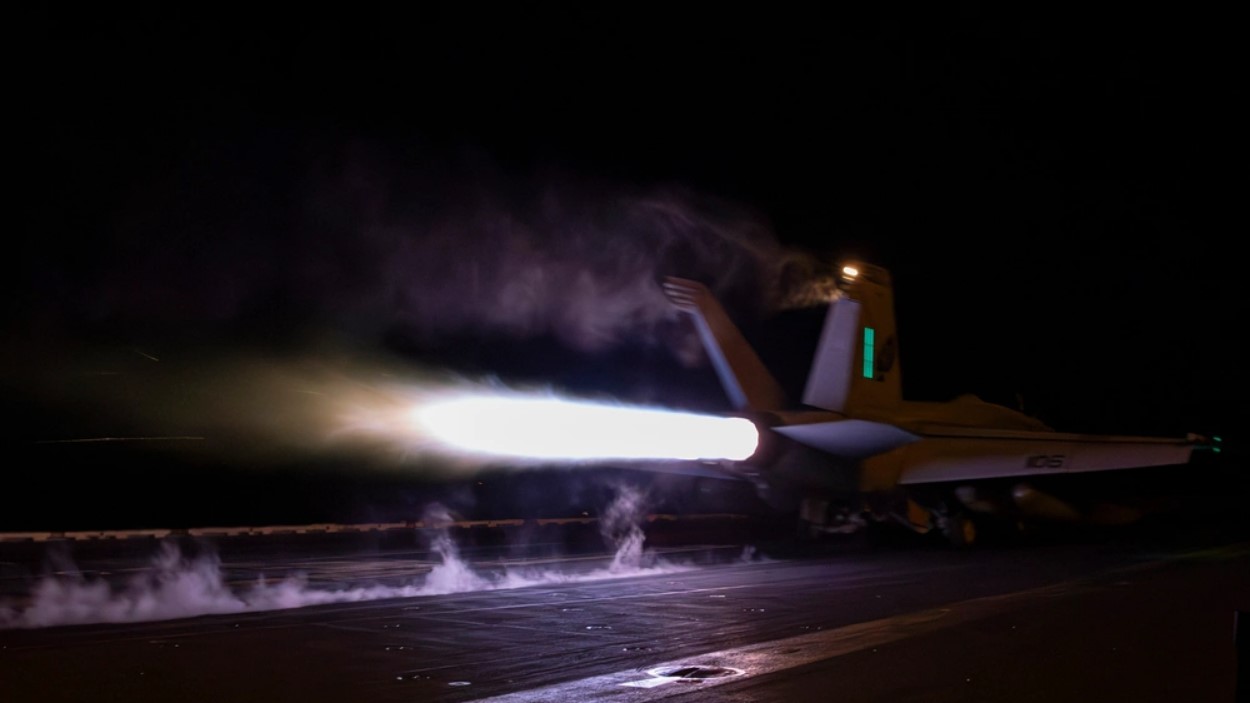

The air crews of Carrier Air Wing 9 deployed to sea not expecting to end up in dozens of sorties, taking part in the largest naval conflict the United States has been in since World War II. But that’s what happened earlier this year when the air wing, assigned to the USS Abraham Lincoln Carrier Strike Group, was ordered into the 5th Fleet’s area of operations in the waters around the Middle East. The wing ended up flying more than 200 sorties in direct combat during the deployment.
The nine squadrons that make up Carrier Air Wing 9 returned to the United States this weekend. As part of their return, U.S. Navy released new details on the Abraham Lincoln Carrier Strike Group’s actions during its time in the 5th Fleet area of operations, fighting against Houthi militants in Yemen. The ships and the carrier wing were leaving the 7th Fleet’s area of responsibility in August when they were ordered by Defense Secretary Lloyd Austin to “accelerate” to the Middle East after a series of Israeli attacks on Iran and its allies during the summer.
For the most part, the U.S. military has been quiet on details behind these operations. Although U.S. Central Command regularly shares updates and brief reports on intercept missions, the exact amount of resources devoted to taking out enemy drones and ballistic missiles isn’t always clear. The information shared by the U.S. Navy makes it clear how involved the different fighter squadrons were in intercepting munitions and drones fired by Houthis and carrying out strikes on Yemen.
One incident involving multiple squadrons was a Houthi attack on the Arleigh Burke-class guided-missile destroyers USS Stockdale and USS Spruance on Nov. 11 when they passed through the Bab al-Mandeb Strait. Although CENTCOM had previously acknowledged the incident, the Navy shared new details. Fighter jets with Strike Fighter Squadron (VFA) 41 and , along with aircraft from Airborne Command & Control Squadron (VAW) 117 took part in identifying and engaging eight one-way attack drones and several missiles fired at the two destroyers. The military had not mentioned the aircraft involvement when announcing the incident last month.
The information comes after the U.S. Navy shared details earlier this month from sailors on the Arleigh Burke-class destroyer the USS Carney, which fended off multiple Houthi attacks on vessels at the start of the conflict in 2023. The Houthis, a militant and nationalist movement in Yemen that controls much of the country including the capital of Sana’a, began attacking ships in the Red Sea and Gulf of Aden in an effort to pressure Israel to stop its war in Gaza, which began after the Oct. 7, 2023 Hamas attacks on Israel.
After arriving in the CENTCOM area of operations in August, the Abraham Lincoln Carrier Strike Group worked alongside the USS Theodore Roosevelt Carrier Strike Group, until that group left in September. Alongside intercept missions, the squadrons took part in offensive operations. Those included major strikes on Houthi military sites over two days in Nov. 9-10. The Marine Corps’ VMFA-314 took part in that operation, the first time that the Marine Corps’ F-35C saw combat. The squadron dropped 72,000 pounds of ordnance while in the Middle East, it reported.
“The capabilities and determination of what our team can do amazes me. We made history during our time in the Middle East all due to the tireless work of our Marines and support of the Carrier Strike Group and U.S. forces,” Lt. Col. Jeffrey Davis, commanding officer of VMFA-314, said in a release for his squadron.
As The Aviationist reported, some of the F-35Cs of VMFA-314 were back at their home base at Marine Corps Air Station Miramar sporting new bomb markings on their fuselage. That includes one jet piloted by Davis.
The exact amount of combat sorties flown in total is unclear. VMFA-314 reported flying 61 sorties in combat operations, while VFA-151 flew 159. Electronic Attack Squadron 133 carried out the first usage of the ALQ-249 Next Generation Jammer in combat on its EA-18G Growlers while flying in the Middle East.
The USS Abraham Lincoln and its supporting ships and aircraft left the Middle East in November; the Pentagon sent B-52 bombers to the region that same month, in part to bolster U.S. air power as the carrier strike group left. This weekend, the USS Harry S. Truman Carrier Strike Group entered the CENTCOM area of responsibility. Alongside the namesake carrier, it includes a guided-missile cruiser, two guided-missile destroyers, a destroyer squadron and Carrier Air Wing 1. Those ships arrived in the region on Saturday, Dec. 14.
The latest on Task & Purpose
- A push to cut veterans disability benefits is gaining traction, experts warn
- A judge ordered the VA to build thousands of new veterans housing units in Los Angeles. An appeals court halted it
- Sailors on USS Carney recall tense night of combat in fierce Red Sea fight
- To build a runway for the new stealth bomber, the Air Force is moving 17 B-1s to a new base
- VFW bashes The Economist for taking ‘turkey-sized dump’ on disabled vets
